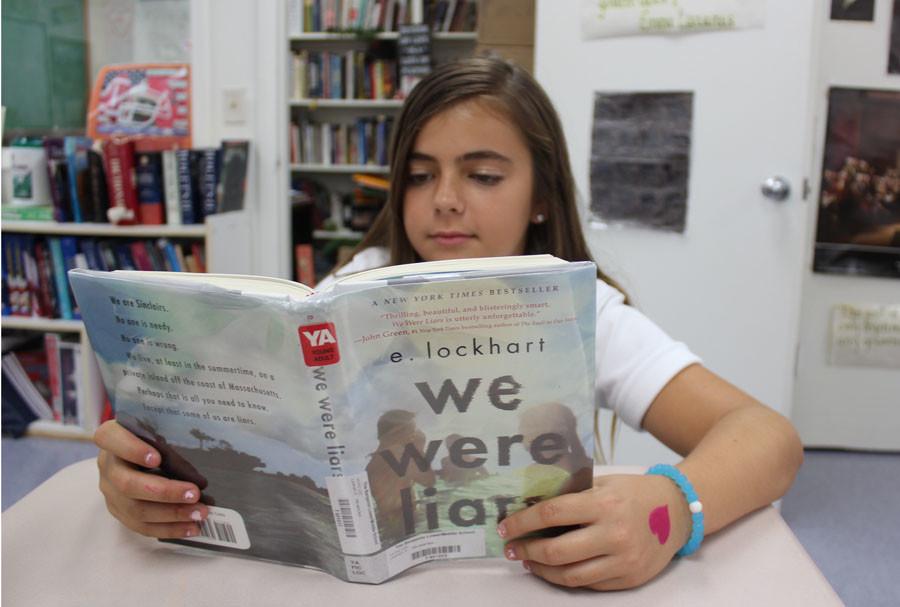The Real Reason for RAAP
During RAAP, seventh grader Sydney Haselkorn reads “We Were Liars” by E. Lockhart, who happened to visit and speak with the middle school students last year.
What if you had the time to read a good book every day? Well, here at Benjamin, you can. Almost every single afternoon of the school year, from 3:00-3:20 p.m., the students have RAAP, a time to read a book of one’s choice. But what exactly does RAAP mean? It seems to be quite an ambiguous thing for many students at TBS.
In a recent survey about what middle school students at Benjamin thought RAAP stood for, there were many varied results. Some phrases students believed RAAP stood for included “Reading Academic Advancement Program,” “Reading Apprehension and Appreciation,” and “Reading And Academic Preparations.” Although the survey was anonymous, eighth grader Blake Prolow threw his hat into the ring and proudly declared, “[RAAP] stands for ‘Reading And After Period.’”
RAAP’s real meaning is Reading Advocacy Advisory Program. Out of 50 Benjamin middle school students surveyed, only 7 knew the correct answer. Are these stats showing that the true meaning and benefit of RAAP should be reinforced? Or does this mean RAAP may need a new name?
RAAP began in 2010 at TBS. It became an institution and was modeled after Drop Everything and Read (DEAR), a national program sponsored by several institutions such as the National Education Association (NEA), the National Parent Teacher Association (PTA), and HarperCollins’ Children’s Books. According to its website, DEAR insists that “folks of all ages [should] ‘drop’ what they’re doing and pick up a book, instead.”.
Middle School English Department Chair Ms. Kathleen Devine wanted to “create a program similar to D.E.A.R., but more intensive,” she said. The main impetus for RAAP, according to a presentation given by Devine, is “if a student reads for 20 minutes a day for 200 days, then they will read 1,000,000 words. Of those, they will not know about 20,000. Research says that students learn 1 in 20 words from the context of the writing, which means that a student following this regimen will learn about 1,000 new words a year, which constitutes a grade level increase in reading skill.” However, while the faculty and administration may be privy to this fact, many students are not – so much so that they are unaware what the acronym “RAAP” means.
Yet, the name may not be fitting at all anymore anyway. First of all, the Reading Advocacy Advisory Program rarely takes place in advisory. Some students may have their advisor’s class last period, but not all do.
Second, while RAAP is meant to be a free time of silent and enjoyable reading for students, some don’t see it as a positive part of their day. The results of the survey showed that some students regarded RAAP as “Reading As A Punishment.”
Teachers, of course, disagree. “Being allowed 20 minutes out of your day to relax and do what most educated human beings are dying to do every day, but can only do on their weekends or vacations, is a luxury,” said Dr. Cristina James, the Middle School’s dean of academics and one of the seventh-grade English teachers.
Seventh-grader Michelle Pfeifer feels the same way. “I think RAAP is good for the students because the School makes us read and some kids are not willing to read if they are not pushed to read,” Pfeifer said.
Even if students aren’t aware of the thousands of new words they are exposed to which will expand their vocabulary, some of them know RAAP is still good for them. “It is important to read, even though I don’t like RAAP or reading,” said seventh-grader Nick Lutz. “It helps you become more well-rounded in all subjects.”
According to Dr. James, whether or not students know what RAAP stands for is secondary to its actual benefits. “As long as the acronym you’re giving to RAAP has to do with [its] merits, I think it doesn’t matter what the actual words are,” James explained.
However, students may be more inclined to participate in RAAP if they know that the end result is an expansion of their own vocabulary which may help them on future standardized tests such as the ACT and SAT. Plus, the students are not assigned specific books, but are able to bring in any novel they choose, making the learning that much more palatable.
If the faculty and administration reinforced the reasons RAAP is practiced in the Middle School, maybe more students would buy in and take advantage of the time allotted to reading at the end of the day. Or, at the very least, they would view RAAP as a privilege to be appreciated rather than a punishment to be put up with.





